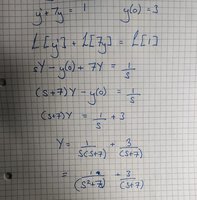You are using an out of date browser. It may not display this or other websites correctly.
You should upgrade or use an alternative browser.
You should upgrade or use an alternative browser.
Laplace transform and partial fractions
- Thread starter Mechaman
- Start date
Assuming that your notation means \( Y = \mathcal{L} \left\{ y(t) \right\} \) then what you've done so far is good, and you're on the right track to think of partial fraction decomposition for the first fraction. You'll want to find an appropriate \(A\) and \(B\) so that:
\(\displaystyle \frac{1}{s(s+7)} = \frac{A}{s} + \frac{B}{s + 7}\)
\(\displaystyle \frac{1}{s(s+7)} = \frac{A(s + 7) + Bs}{s(s+7)} \implies A(s + 7) + Bs = 1\)
This must be true for every value of \(s\) so we can make it easier on ourselves by testing for simple value, say \(s = 0\):
\(\displaystyle A(0 + 7) + B(0) = 1 \implies 7A = 1 \implies A = \frac{1}{7}\)
Then back substitute and discover:
\(\displaystyle 1 = \frac{1}{7}(s + 7) + Bs \implies Bs + \frac{s}{7} = 0 \implies B = -\frac{1}{7}\)
Therefore:
\(\displaystyle \frac{1}{s(s+7)} = \frac{1}{7s} - \frac{1}{7(s + 7)}\)
And so:
\(\displaystyle Y = \frac{1}{7s} - \frac{1}{7(s + 7)} + \frac{3}{s+7}\)
\(\displaystyle y(t) = \mathcal{L}^{-1} \left( \frac{1}{7s} - \frac{1}{7(s + 7)} + \frac{3}{s+7} \right)\)
I trust you can finish up from here?
\(\displaystyle \frac{1}{s(s+7)} = \frac{A}{s} + \frac{B}{s + 7}\)
\(\displaystyle \frac{1}{s(s+7)} = \frac{A(s + 7) + Bs}{s(s+7)} \implies A(s + 7) + Bs = 1\)
This must be true for every value of \(s\) so we can make it easier on ourselves by testing for simple value, say \(s = 0\):
\(\displaystyle A(0 + 7) + B(0) = 1 \implies 7A = 1 \implies A = \frac{1}{7}\)
Then back substitute and discover:
\(\displaystyle 1 = \frac{1}{7}(s + 7) + Bs \implies Bs + \frac{s}{7} = 0 \implies B = -\frac{1}{7}\)
Therefore:
\(\displaystyle \frac{1}{s(s+7)} = \frac{1}{7s} - \frac{1}{7(s + 7)}\)
And so:
\(\displaystyle Y = \frac{1}{7s} - \frac{1}{7(s + 7)} + \frac{3}{s+7}\)
\(\displaystyle y(t) = \mathcal{L}^{-1} \left( \frac{1}{7s} - \frac{1}{7(s + 7)} + \frac{3}{s+7} \right)\)
I trust you can finish up from here?
D
Deleted member 4993
Guest
A quicker way to calculate the "partial fraction" coefficients:Assuming that your notation means \( Y = \mathcal{L} \left\{ y(t) \right\} \) then what you've done so far is good, and you're on the right track to think of partial fraction decomposition for the first fraction. You'll want to find an appropriate \(A\) and \(B\) so that:
\(\displaystyle \frac{1}{s(s+7)} = \frac{A}{s} + \frac{B}{s + 7}\)
\(\displaystyle \frac{1}{s(s+7)} = \frac{A(s + 7) + Bs}{s(s+7)} \implies A(s + 7) + Bs = 1\)
This must be true for every value of \(s\) so we can make it easier on ourselves by testing for simple value, say \(s = 0\):
\(\displaystyle A(0 + 7) + B(0) = 1 \implies 7A = 1 \implies A = \frac{1}{7}\)
Then back substitute and discover:
\(\displaystyle 1 = \frac{1}{7}(s + 7) + Bs \implies Bs + \frac{s}{7} = 0 \implies B = -\frac{1}{7}\)
Therefore:
\(\displaystyle \frac{1}{s(s+7)} = \frac{1}{7s} - \frac{1}{7(s + 7)}\)
And so:
\(\displaystyle Y = \frac{1}{7s} - \frac{1}{7(s + 7)} + \frac{3}{s+7}\)
\(\displaystyle y(t) = \mathcal{L}^{-1} \left( \frac{1}{7s} - \frac{1}{7(s + 7)} + \frac{3}{s+7} \right)\)
I trust you can finish up from here?
\(\displaystyle \frac{1}{s(s+7)} = \frac{A}{s} + \frac{B}{s + 7}\)
Multiply both sides by 's':
\(\displaystyle \frac{1}{(s+7)} = A + \frac{B * s}{s + 7}\)
Calculate \(\displaystyle \lim_{s \to 0}\) of both sides:
1/7 = A
Now - again
\(\displaystyle \frac{1}{s(s+7)} = \frac{A}{s} + \frac{B}{s + 7}\)
Multiply both sides by '(s+7)':
\(\displaystyle \frac{1}{s} = B + \frac{A * (s+7)}{s}\)
Calculate \(\displaystyle \lim_{s \to {-7}}\) of both sides:
-1/7 = B
Same answer as Ksd - just a bit quicker!
- Joined
- Apr 12, 2005
- Messages
- 11,325
Never been a fan of this. s = 0 is not in the Domain. The method works fine. I just find it fundamentally unsatisfying.This must be true for every value of \(s\) so we can make it easier on ourselves by testing for simple value, say \(s = 0\):

